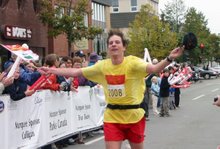Photos below by Chris Madden,
Community Liaison, Cycle to Walk
On Tuesday, September 16th, Alex and I were honoured to join Ramesh Ferris and, along with
Cpl. Dave Cheverie, escort him through the streets of Charlottetown on his cross-Canada
Cycle to Walk.
When I first heard about Ramesh's campaign, to "r
aise funds and awareness to forward the global eradication of polio, to educate about the continuing need for immunization against polio and to support the rehabilitation of polio survivors in poor countries." I felt obligated to lend our voices to his mission. As a parent in the autism community I know too well that the declining vaccination rates - 11% of Canadians are not vaccinated against Polio - have much to do with the much discreddited myth that 'vaccines cause autism', a myth perpetuated by some of the more vocal and anti-science parents in the autism community.

A recent headline in the New York Times read "
Measles Cases Grow in Number, and Officials Blame Parents"
"More people had measles infections in the first seven months of this year than during any comparable period since 1996, and public health officials blamed growing numbers of parents who refuse to vaccinate their children.
Many of these parents say they believe vaccines cause autism, even though multiple studies have found no reputable evidence to support such a claim. In Britain, Switzerland, Israel and Italy, measles outbreaks have soared, sickening thousands and causing at least two deaths."
This "
better dead than autistic" attitude is not only extremely offensive, it is anti scientific fear mongering that is putting our children and out society at risk.
 Ramesh tells us
Ramesh tells us "According to WHO calculations, the rate of immunization [against Polio] is presently low enough to put Canada at risk for at least localized outbreaks."
“As long as a single child remains infected with the poliovirus, children in all countries are at risk of contracting the disease. The poliovirus can easily be imported into a polio-free country and can spread rapidly amongst immunized populations. Between 2003 and 2005, 25 previously polio-free countries were reinfected due to importations.” - (WHO)
There are few children for who vaccines are contraindicated and those children, babies too young to be immunized and those for whom the vaccine does not work depend on
herd immunity to keep them safe. Please, unless your Doctor advises against it, please immunize your children. It is absolutely NOT better to risk death by a disease that can be prevented by vaccine. Countless peer reviewed scientific studies have shown NO LINK between vaccines and autism. Your children deserve this high standard of scientific evidence. New age, pseudo scientific celebrities who depend on Google for their education should not be trusted with your children's lives.
"No single medical advance has had a greater impact on human health than vaccines. Before vaccines, Americans could expect that every year measles would infect four million children and kill 3,000; diphtheria would kill 15,000 people, mostly teenagers; rubella (German measles) would cause 20,000 babies to be born blind, deaf, or mentally retarded; pertussis would kill 8,000 children, most of whom were less than one year old; and polio would paralyze 15,000 children and kill 1,000."
Dr. Paul Offit MD, author of Autism's False Prophets: Bad Science, Risky Medicine, and the Search for a Cure
(Paul A. Offit, MD, is a pediatrician specializing in infectious disease medicine, an internationally known expert on vaccines, immunology, and virology, the Maurice R. Hilleman Professor of Vaccinology, Professor of Pediatrics at the University of Pennsylvania, Chief of the Division of Infectious Diseases, and the Director of the Vaccine Education Center at The Children's Hospital of Philadelphia. Offit has been a member of the Centers for Disease Control's (CDC) Advisory Committee on Immunization Practices. Offit has published more than 130 papers in medical and scientific journals in the areas of rotavirus-specific immune responses and vaccine safety and is the co-inventor of a rotavirus vaccine )
Smallpox -- a disease estimated to have killed 500 million people -- was eradicated from the face of the earth by vaccines. Polio stands to be the second disease eradicated from the planet.
The US$200 million funding agreement between Rotary and the Bill & Melinda Gates Foundation marks another milestone in Rotary’s 20-year legacy of polio eradication work.
Rotary, a volunteer service organization of 1.2 million men and women, made a commitment to immunize the world’s children against polio in 1985 and became a spearheading partner in the Global Polio Eradication Initiative three years later. The other partners are the World Health Organization, the U.S. Centers for Disease Control and Prevention, and UNICEF.
Rotary’s primary responsibilities include fundraising, advocacy, and volunteer recruitment. To date, Rotary has contributed nearly $700 million to the eradication effort, an amount that will grow to more than $850 million by the time the world is certified polio-free.
[...]
Thanks to Rotary and its partners, the number of polio cases has been slashed by more than 99 percent, preventing five million instances of childhood paralysis and 250,000 deaths. When Rotary began its eradication work, polio infected more than 350,000 children annually. In 2007, fewer than 2,000 cases were reported worldwide.
But the polio cases represented by that final 1 percent will be the most difficult and expensive to prevent for a variety of reasons, including geographical isolation, worker fatigue, armed conflict, and cultural barriers.
That’s why it’s so important to generate the funding needed to finish the job. To ease up now would be to invite a polio resurgence that would condemn millions of children to lifelong paralysis in the years ahead.
The bottom line is this: As long as polio threatens even one child anywhere in the world, all children – wherever they live – remain at risk.
--Source
We were proud to join Ramesh and support his campaign to eradicate Polio, educate Canadians on the importance of immunization and support the rehabilitation of Polio survivors in poor countries. Please take a moment to visit Ramesh's website
www.cycletowalk.com and consider showing your support by
donating to the Cycle to Walk and/or
emailing him some words of encouragement.
Thank you to Ramesh, Chris and the rest of the Cycle to Walk crew. It was a pleasure to meet you all and spend a bit of time together. We wish you a safe & successful journey as you make your way to Newfoundland.
See all the photos Chris Madden & I took that day here.
You can hear Ramesh tell his story here on this YouTube video.
Watch Alex try out Ramesh's hand cycle here.Below is Ramesh's blog post of Tuesday, September 16th:
 Follow Ramesh's Journey
Follow Ramesh's Journey
Day 158- Charlottetown, PEI- (Non-Official Route Cycling)  The team hit the road at 6 am today to visit Rotarians in Sunnyside, PEI. The club’s president, Sandy Rundle, announced that the club has been so inspired by Cycle to Walk that they will make a significant contribution to Rotary International’s PolioPlus program in honour of Cycle to Walk in the near future. After some best wishes, donations and an interview with the local paper, we headed back to Charlottetown – but not without stopping to check out the Confederation Bridge first.
The team hit the road at 6 am today to visit Rotarians in Sunnyside, PEI. The club’s president, Sandy Rundle, announced that the club has been so inspired by Cycle to Walk that they will make a significant contribution to Rotary International’s PolioPlus program in honour of Cycle to Walk in the near future. After some best wishes, donations and an interview with the local paper, we headed back to Charlottetown – but not without stopping to check out the Confederation Bridge first.
Back when we first arrived on the island, we were invited to visit MacQueen’s Bicycle Shop in Charlottetown to get the bike serviced. This morning we took it in for one last tune up, cable replacement, and brake alignment. I believe that now the hand cycle will handle the final 500 km of the Cycle to Walk cross-Canada tour with no problems.
Dr. Sean Wiebe of from the University of Prince Edward Island’s Global Issues class invited the team to speak with his students today. Just like yesterday’s class, students demonstrated lots of interest in the Cycle to Walk campaign and asked lots of questions. Thank-you to all of the staff and students at the UPEI for showing so much care and support for the team and the message of Cycle to Walk. Education about polio must continue both in and out of the classroom. We need to work together as a global community to eradicate polio once and for all.
11 per cent of Canada’s population has not received the polio vaccination. That means over 3.4 million Canadians are at risk of contracting the poliovirus. There are a number of reasons why Canadians are not receiving the polio vaccine, such as an ‘out of sight/out of mind’ attitude, miseducation that polio has already been eradicated, or myths that the polio vaccinations lead to side effects such as autism.
There is absolutely no scientific evidence that the polio vaccination is responsible for causing autism.
It’s important for parents to ensure that their children receive the three doses of the polio vaccine at two, four and six months of age. Even adults need to ensure that their immunizations are up to date – especially if travelling overseas. Anyone who has not received the three doses of the polio vaccine can be a carrier of the virus, putting others at risk of contracting polio.
This afternoon, I hand cycled through the streets of Charlottetown accompanied by a local PEI Hero by the name of Alex Bain. Alex is 20, and he lives with autism spectrum disorder. Both he and his mother Janet were so excited to join in support of the Cycle to Walk campaign and share the important message that people need to continue to receive the polio vaccine. Alex had absolutely no problems keeping up as he is known for his long distance marathon running. In 2006, Alex ran across Prince Edward Island – tip to tip – to raise awareness about autism and to celebrate ability. It’s reassuring and wonderful to know a person living with autism who is willing to put himself in the public and show support for the polio vaccine. Thank you so much, Alex, your support. It means a lot to me, and it was great to spend part of the afternoon with you. View Janet and Alex’s blog entry here.
Alex, Janet and Iwere kept nice and safe because of the great work of
Corporal Dave Cheverie of the Charlottetown Police. Thanks, Corporal Cheverie, for the lights, sirens, safety, and support.
We ended our day back on campus at the UPEI to speak at Campus Kids daycare. What a treat it was to be surrounded by such attentive, inquiring, smiling, and supportive young children. Thank you to Trish Daley, daycare staff, and all of the children. You truly brought a lot of joy into our day when you demonstrated so much interest to learn more about polio and the Cycle to Walk campaign.
It’s unbelievable, but our time is quickly coming to an end here in PEI. The team will catch the Wood Island ferry back to Nova Scotia tomorrow morning continue eastward on our journey. Thank you so much to our wonderful hosts, the Campbells and the Mathesons for hosting the team over the last couple of days!
Polio still a problem: activist
STEPHEN BRUN
The Journal Pioneer
 SUMMERSIDE – Ramesh Ferris is a study in contrasts as a survivor of polio.
SUMMERSIDE – Ramesh Ferris is a study in contrasts as a survivor of polio.As a six-month-old in India, the disease crippled his legs. But he is now nearing the end of a cross-Canada awareness campaign that demonstrates what proper rehabilitation can do for polio survivors.
Ferris is using a hand cycle to travel across Canada to raise awareness for the eradication of polio. He said Canadians have become complacent about vaccinations over time, while some even think the disease no longer exists.
“We’ve had a prevention for over 53 years, yet children continue to die and become paralyzed by the effects of polio,” said Ferris at a recent Summerside Rotary meeting.
“If we choose not to continue the fight against polio, an additional 10 million children will be paralyzed over the next 40 years and we risk losing the $4-billion global investment we’ve put into the eradication efforts.”
Ferris began his Cycle to Walk campaign on April 12 in Vancouver in honour of the date in 1955 when Jonas Salk’s polio vaccine was released.
To date, he has travelled 6,700 kilometres and will end his cycle at Cape Spear, Nfld., on Oct. 1. Ferris plans to eventually raise $1 million, 75 per cent of which will go to Rotary’s Polio Plus program, while 20 per cent will go to polio survivors in poor countries and five per cent will be spent on education about the disease.
“It’s a reminder that there’s still people dying from the effects of this horrible disease that we should’ve eradicated years ago,” he said.
“My drive and my passion toward doing that won’t stop in Newfoundland.”
In India, because his mother didn’t have access to the health care Ferris needed, an Anglican bishop in the Yukon adopted him as a two-year-old in 1982.
He was able to access the braces, crutches and surgeries he needed in Vancouver, and took his first steps with crutches a year later.
“It’s challenging, but I’m an example of what can happen if one doesn’t receive the vaccination, but what can happen if one has access to the proper rehabilitative care.”
Although great strides have been made against polio — it is only endemic in four countries around the world — new cases still crop up because people still don’t get the proper immunizations. This is something Ferris would like to change.
“As long as there’s a single case of polio, no country is polio-free.”
newsroom@journalpioneer.com























































